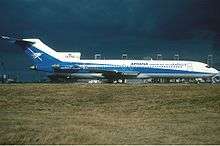1998 Ariana Afghan Airlines crash
The 1998 Ariana Afghan Airlines crash was a flight operated by an Ariana Boeing 727-200. The flight crashed on approach into Kabul killing all 45 aboard. The flight may have been involved in illegal smuggling and Islamic militant operations, as Ariana Afghan Airlines was back then controlled by the Taliban-led Islamic Emirate of Afghanistan regime.
 YA-FAZ, the aircraft involved in the accident. | |
| Occurrence | |
|---|---|
| Date | 19 March 1998 |
| Summary | Controlled flight into terrain of undetermined cause |
| Site | Sharki Baratayi Mountain |
| Aircraft | |
| Aircraft type | Boeing 727-228 |
| Operator | Ariana Afghan Airlines |
| Registration | YA-FAZ |
| Flight origin | Sharjah International Airport, Sharjah, United Arab Emirates |
| Stopover | Kandahar Airport, Kandahar, Afghanistan |
| Destination | Kabul International Airport, Kabul, Afghanistan |
| Occupants | 45 |
| Passengers | 35 |
| Crew | 10 |
| Fatalities | 45 |
| Survivors | 0 |
Accident
The flight departed the city of Sharjah in the United Arab Emirates to Kabul on an unscheduled flight with a stop in Kandahar, Afghanistan. While descending for Kabul International Airport, the flight struck the Sharki Baratayi Mountain at an altitude of 2,700 feet (820 m) at 13:00 local time. The crash killed all 10 crew members and 35 passengers. The weather at the time of the accident was poor with snow and rain as well as poor visibility.[1]
Aircraft
The flight was operated by a Boeing 727-228, registered YA-FAZ. The aircraft first flew on 22 January 1981, meaning at the time of the accident, it was 17.2 years old.[2]
Aftermath
During rescue operations, Taliban regime members and Ariana officials reportedly carried 32 bodybags and another 15 bags with body parts from mountain. Rescue work was delayed by bad weather and from the aircraft's wreckage being on fire until 03:00 (local time) of the next day. The rescue attempt was difficulted by landmines planted in the area during the 1979-89 Soviet invasion. An Ariana official said on March 20 that the plane was carrying 32 passengers and 13 crew members.[3]
Even if the aircraft's black boxes were reportedly searched for, there is no trace of either a report or an investigation to either determine the causes of the accident or the fate of the black boxes (possibly a consequence of the Taliban regime's international isolation). The director-general of Ariana Afghan Airlines, Hassan Jan, said that the crash was a consequence of bad weather.[4]
The crash was one of several incidents that would lead to Ariana Airlines being prohibited from EU airspace.[5]
Taliban and Al-Qaeda operations
According to a November 2001 Los Angeles Times story, this flight may have been one of several involved in a series of smuggling runs carrying arms, money, drugs and Islamic militants between Sharjah, Pakistan and Afghanistan. Passengers in these flights reportedly included militants from both the Al-Qaeda and Taliban movements, the latter of which ruled most of Afghanistan between 1996 and 2001, while also harboring Osama bin Laden. Being the regime that controlled most of Ariana's fleet and assets, as well as the airports in Kandahar and Kabul, the Taliban facilitated the flights, helping to provide fake crew and employee IDs to the militants. According to the LA Times report, the pilots of this particular flight may have been Taliban themselves. The story reports on an August 1996 incident, in which Ahmad Shah Massoud's militia stopped an Ariana 727 that was about to depart from Jalalabad Airport full of opium hidden in a fake timber cargo. US intelligence officials were reportedly aware of these flights and the use that the Taliban regime was giving to Ariana Afghan.[6]
References
- Ranter, Harro. "Ariana crash information". aviation-safety.net. Aviation Safety Network. Retrieved 27 October 2018.
- "Aircraft Data YA-FAZ, 1980 Boeing 727-228 C/N 22288". www.airport-data.com. Retrieved 2020-03-05.
- 20 March 1998 Sharki Baratayi, Afghanistan https://www.emerald.com/insight/content/doi/10.1108/dpm.1999.07308aac.009/full/html
- ibid
- Cornwell, Alexander (10 January 2014). "Blacklisted airlines in EU flying in UAE". Gulf News. Retrieved 27 October 2018.
- Braun, Stephen; Pasternak, Judy (2001-11-18). "Long Before Sept. 11, Bin Laden Aircraft Flew Under the Radar". Los Angeles Times. Retrieved 2020-03-05.